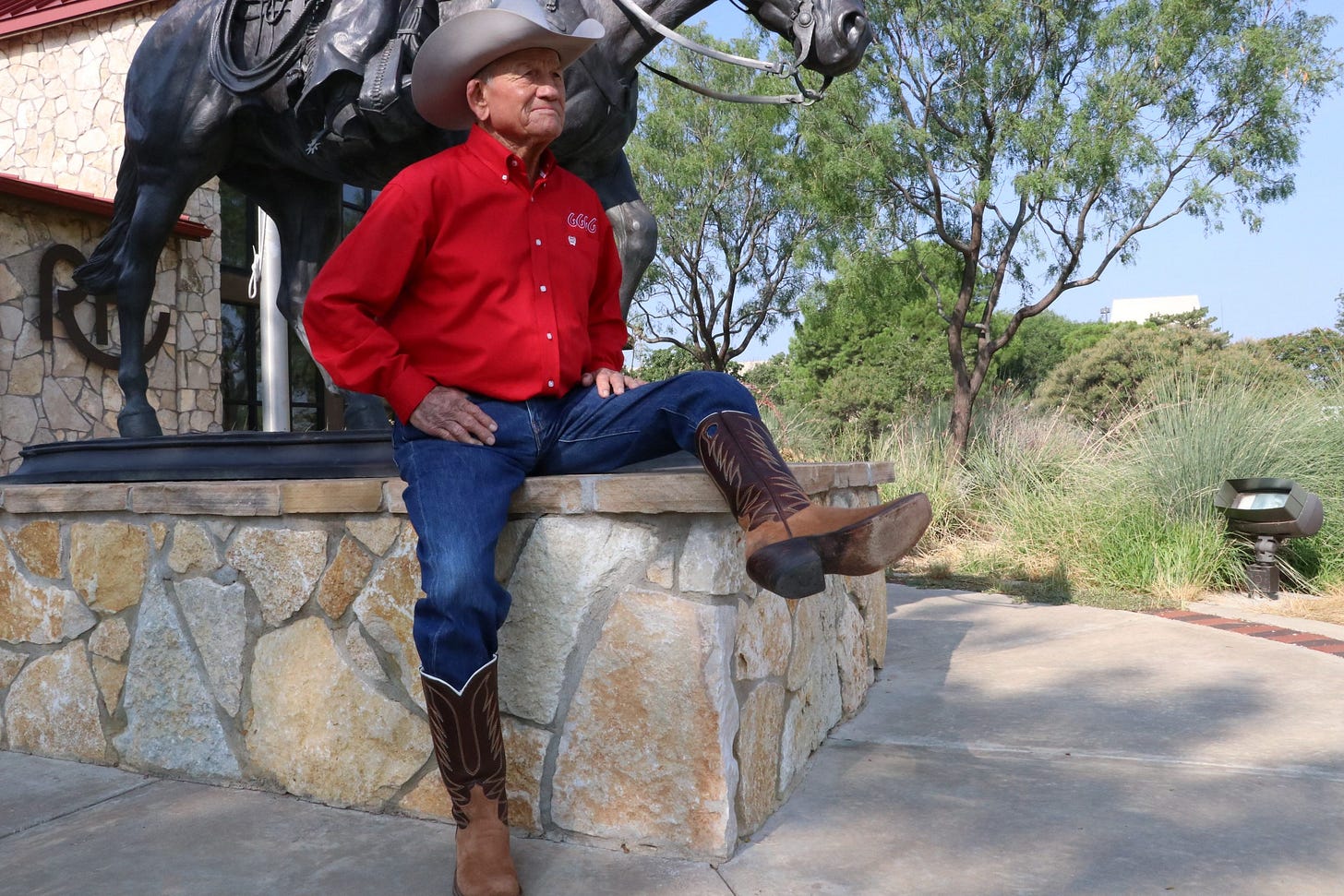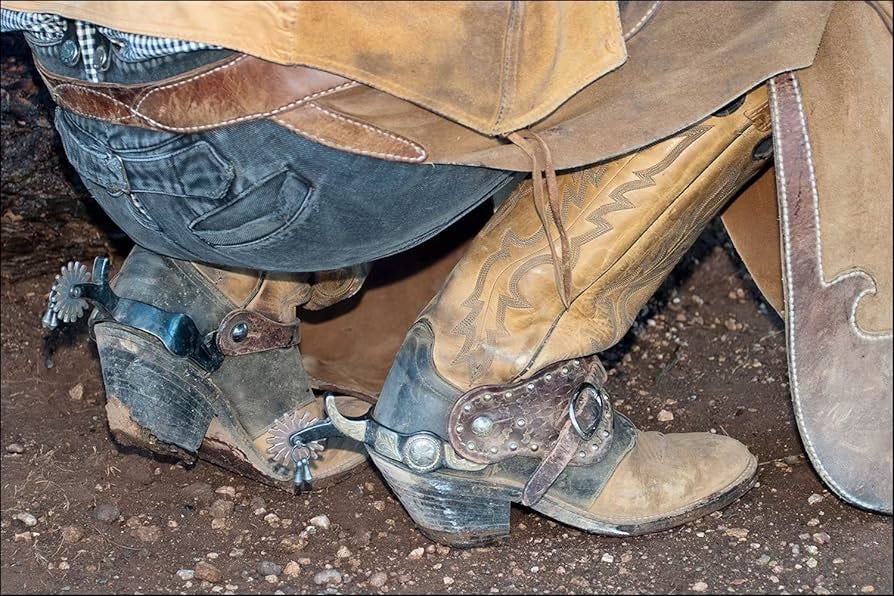Cowboy Etiquette: The Cowboy Boot
A cowboy must . . . have a pair of fancy chapereros, or overalls, made out of calf skin, or stamped leather. Boots with high French heels are indispensable. –General George Wingate
Y’allogy is 1836 percent pure bred, open range guide to the people, places, and past of the great Lone Star. We speak Texan here. Y’alloy is free of charge, but I’d be much obliged if you’d consider riding for the brand as a paid subscriber. (Annual subscribers of $50 receive, upon request, a special gift: an autographed copy of my literary western, Blood Touching Blood.)
Ain’t no man a cowboy without a broad, stiff hat upon his head and a pair of tough, sturdy boots upon his feet. When it comes to the cowboy’s costume, those two—the hat and boots—are the iconic emblems of every puncher. Starting with these foundational items, each hand could dress up or down as he pleased, or as the range he worked dictated or his money could procure. In general, however, each cowboy wore similar clothing. Granville Stuart, a Montana cowman, wrote in the late 1880s, “They wore the best clothes that they could buy and took great pride in their personal appearance and in their trappings.”
The men of our outfit used to pay $25.00 a pair for made-to-order riding boots when the best store boots in Helena were $10.00 a pair. Their trappings consisted of a fine saddle, silver mounted bridle, pearl-handled six shooter, latest model cartridge belt with silver buckle, silver spurs, a fancy quirt with silver mountings, a fine riata sometimes made of rawhide, a pair of leather chaps, and a fancy hatband often made from the dressed skin of a diamond-backed rattlesnake. They wore expensive stiff-brimmed light felt hats, with brilliantly colored silk handkerchiefs knotted about their necks, light colored shirts and exquisitely fitted very high heeled riding boots.
Old time Texas cowboys, which I’m most familiar with since Texas is my gathering ground, were so proud of the boots they wore they almost always ordered them custom made with a Lone Star tooled into the shaft. In the 1870s and 1880s handmade boots cost anywhere from $12 to $20 a pair. A tidy sum. The average cowboy in the 1880s, based on his experience and ability, only made $35 to $45 a month.
On Tucking Jeans into Boots
Old-timers, as well as new-timers, always tucked or “bloused” their pant legs into their boots—in Texas anyway. During my goat roping days—slang for anyone who rode horses, was in 4H, or was otherwise associated with cowboy culture—I wore the inside portion of my jeans inside my boots. That sounds dumb. But I can assure you, it’s dumber looking than it sounds—the following tidbit notwithstanding. Some cattlemen back in the day claimed a man’s cattle wealth could be determined by how he tucked his britches.
One leg partially tucked meant he owned 25 head.
One leg completely tucked meant he owned 50 head.
Two legs partially tucked meant he owned 75 head.
Two legs completely tucked meant he owned a 100 or more head.
Today, with so many Arbuckles* walking around the question to tuck or not to tuck is a common one. The Texanist, writing for Texas Monthly, answered the question with another question: “No matter how ridiculous I look, do I really give a damn what anybody thinks when I tuck my jeans into my boots?” Unlike the Texanist, it’s not my place to judge another man’s fashion choices.† Nevertheless, conventional cowboy fashion says not to tuck. However, if you decide to buck convention there are only two reasons to tuck—one is practical and one is fashionable.
The Fashionable Reason to Tuck
Whether we’re talking about the Old West or the New West the only voguish reason to tuck your pants into your boots is to show off fancy leather work and/or stitching on the shaft (upper portion) of your boots. As Stuart said, cowboys “took pride in their personal appearance and in their trappings.” Whether old or new, cowboys like to one-up each other, even in the manner of their boots.
The Practical Reasons to Tuck
The pragmatic reasons to tuck your jeans into your boots really only applies to working cowboys (though I recently saw an Oklahoma cowboy with his jeans untucked). Even though working hands uniformly wear chaps (full-length leather leggings) or chinks (half-length leather leggings) they still blouse their britches—and for these reasons:
To protect their jeans from mud and muck, which is cow and/or horse manure mixed with mud.
To keep their pants from snagging on brush, especially in South Texas.
To keep their britches from getting caught on their spurs.
To protect their legs from thorns, ticks, cactus needles, snakes, and horse bites.
To protect the inside of their legs from chaffing while riding.
So, should you tuck or not tuck? I’d say don’t tuck, unless you’re working cattle or riding horses—or have a particularly striking pair of boots you want to show off and don’t mind folks looking at you like a knothead. (Oops, I guess I violated my earlier statement about not judging another man’s fashion choices.)
On Heel Height & Toe Shape
The tuck/no tuck question is most commonly asked by drugstore cowboys. Other questions they typically ask concern heel height and toe shape. Answers for both are the same and simple: it’s a matter of personal preference and comfort.
Heel Height
George Wingate said “high French heels [were] indispensable” to working cowboys of the 1880s. There were a two reasons for this. First, while in the saddle a high heel helped the cowpuncher keep his foot in the stirrup while working cattle. Second, while on the sidewalk a high heel elongated a cowboy’s stature, making him appear taller than he probably was since the average height of those punching cattle in the 1880s was 5 foot 7 inches.
When it comes to picking the right heel height there are basically three cowboy heels to pick from—though there are variations.
The Cowboy Heel—sometimes called the “French Heel” or the “Riding Heel.” These are generally somewhere between 11/2 inches to 2 inches high. The back of the heel is usually sloped or slanted inward. Working cowboy wear these because they’re great for riding. They’re not great for walking.
The Fowler Heel—so named for John Fowler, the inventor in 1883. These are typically 11/4 inches high, like a man’s dress shoe, and are either straight-backed or slanted. This is a good overall heel for riding and working on the ground in the round pen or corrals.
The Roper Heel—so named because it’s favored by rodeo cowboys who perform as calf ropers or tie down ropers who are required to jump from their horse, run to roped calves, flank them, and then tie them. The heel hight on these measure no more than 1 inch, whether sloped or straight. Ropers are perhaps the most comfortable to walk in.
Toe Shape
Within the past decade or so a controversy has arisen about appropriate toe shape and whether one style over another marks off a true puncher or a Monkey-Ward cowboy. In general, there are four different toe shapes.
Pointed
Snipped
Rounded
Squared
It’s the squared toe that has become controversial. Many who favor rounded toe boots accuse square-toed wearers as betraying cowboy tradition, even though most boots worn by cowboys in the 1880s wore rounded and squared toes. (Pointed-toed boots didn’t come into fashion until the 1940s.) So, if you prefer square-toed boots, as I do, don’t let some flat-heeled peeler tell you that real cowboys never wear square-toed boots. If they do, show them a photograph of cowboy legend Boots O’Neal in his square-toed boots. And if the phildoodle doesn’t know Boots, then he doesn’t know beans about boots.

* See “Saddle Slickers, Heel Squatters, and Other Cowboy Names” for a definition of slang terms used throughout this article.
† As I said in “Cowboy Etiquette: The Cowboy Hat”: “Cowgirls can pretty much get away with anything. Them’s are the rules.” This applies to tucking or not tucking as well.
✭
Granville Stuart, Forty Years on the Frontier (Cleveland: The Arthur H. Clark Co., 1925), vol. 2, 181.
General George Wingate, “My Trip to the Yellowstone,” American Agriculturalist, vol. XLV (1886), 152.
✭ ✭ ✭
Support Y’allogy—
Much obliged, y’all.




Good read. Especially the part about the toe shape. I’ve heard a lot of wanna be cowboys refer to squared toes as “farmer boots.”
I haven't worn a pair of cowboy boots in a long time, but I remember preferring the roper, round-toed boots to all the others. They were definitely the most comfortable. I didn't know the pointed-toe boots only became popular in the 1940s. Man, this is a great breakdown of cowboy boots through the ages. Awesome job, Derrick.